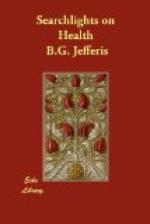2. Homer also tells us of the cestus or girdle of Venus, which was borrowed by the haughty Juno with a view to increasing her personal attractions, that Jupiter might be a more tractable and orderly husband.
3. Coming down to the later times, we find the corset was used in France and England as early as the 12th century.
4. The most extensive and extreme use of the corset occurred in the 16th century, during the reign of Catherine de Medici of France and Queen Elizabeth of England. With Catherine de Medici a thirteen-inch waist measurement was considered the standard of fashion, while a thick waist was an abomination. No lady could consider her figure of proper shape unless she could span her waist with her two hands. To produce this result a strong rigid corset was worn night and day until the waist was laced down to the required size. Then over this corset was placed the steel apparatus shown in the illustration on next page. This corset-cover reached from the hip to the throat, and produced a rigid figure over which the dress would fit with perfect smoothness.
[Illustration: Steel Corset worn in Catherine’s time.]
5. During the 18th century corsets were largely made from a species of leather known as “Bend,” which was not unlike that used for shoe soles, and measured nearly a quarter of an inch in thickness. One of the most popular corsets of the time was the corset and stomacher shown in the accompanying illustration.
6. About the time of the French Revolution a reaction set in against tight lacing, and for a time there was a return to the early classical Greek costume. This style of dress prevailed, with various modifications, until about 1810 when corsets and tight lacing again returned with threefold fury. Buchan, a prominent writer of this period, says that it was by no means uncommon to see “a mother lay her daughter down upon the carpet, and, placing her foot upon her back, break half a dozen laces in tightening her stays.”
7. It is reserved to our own time to demonstrate that corsets and tight lacing do not necessarily go hand in hand. Distortion and feebleness are not beauty. A proper proportion should exist between the size of the waist and the breadth of the shoulders and hips, and if the waist is diminished below this proportion, it suggests disproportion and invalidism rather than grace and beauty.
8. The perfect corset is one which possesses just that degree of rigidity which will prevent it from wrinkling, but will at the same time allow freedom in the bending and twisting of the body. Corsets boned with whalebone, horn or steel are necessarily stiff, rigid and uncomfortable. After a few days’ wear the bones or steels become bent and set in position, or, as more frequently happens, they break and cause injury or discomfort to the wearer.




